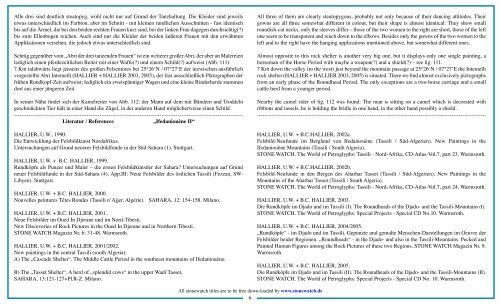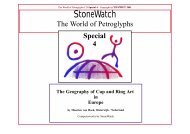StoneWatch The World of Petroglyphs
StoneWatch The World of Petroglyphs
StoneWatch The World of Petroglyphs
Erfolgreiche ePaper selbst erstellen
Machen Sie aus Ihren PDF Publikationen ein blätterbares Flipbook mit unserer einzigartigen Google optimierten e-Paper Software.
Alle drei sind deutlich steatopyg, wohl nicht nur auf Grund der Tanzhaltung. Die Kleider sind jeweils<br />
etwas unterschiedlich im Farbton, aber im Schnitt - mit kleinen rundlichen Ausschnitten - fast identisch<br />
bis auf die Ärmel, die bei den beiden rechten Frauen kurz sind, bei der linken Frau dagegen durchsichtig(?)<br />
bis zum Ellenbogen reichen. Auch sind nur die Kleider der beiden äußeren Frauen mit den erwähnten<br />
Applikationen versehen, die jedoch etwas unterschiedlich sind.<br />
Schräg gegenüber vom „Abri der drei tanzenden Frauen“ ist ein weiterer großer Abri, der aber an Malereien<br />
lediglich einen pferdezeitlichen Reiter mit einer Waffe(?) und einem Schild(?) aufweist (Abb. ).<br />
7 Km talabwärts liegt jenseits des großen Felsentores bei 25°26‘N / 07°27‘E der inzwischen ausführlich<br />
vorgestellte Abri Intemeïlt (HALLIER + HALLIER 2003, 2005), der fast ausschließlich Piktographen der<br />
frühen Rundkopf-Zeit aufweist; lediglich ein zweispänniger Wagen und eine kleine Rinderherde stammen<br />
dort aus einer jüngeren Zeit.<br />
In seiner Nähe findet sich der Kamelreiter von Abb. 112: der Mann auf dem mit Bändern und Troddeln<br />
geschmückten Tier hält in einer Hand die Zügel, in der anderen Hand möglicherweise einen Schild.<br />
------------------------------------------------------------------------------------------------------------------------------<br />
Literatur / References „Ifedaniouène II“<br />
HALLIER, U.W., 990.<br />
Die Entwicklung der Felsbildkunst Nordafrikas.<br />
Untersuchungen auf Grund neuerer Felsbildfunde in der Süd-Sahara ( ). Stuttgart.<br />
HALLIER, U.W. + B.C. HALLIER, 999.<br />
Rundköpfe als Punzer und Maler – die ersten Felsbildkünstler der Sahara? Untersuchungen auf Grund<br />
neuer Felsbildfunde in der Süd-Sahara (4). App.III: Neue Felsbilder des östlichen Tassili (Fezzan, SW-<br />
Libyen). Stuttgart.<br />
HALLIER, U.W. + B.C. HALLIER, 2000.<br />
Nouvelles peintures Têtes Rondes (Tassili n’Ajjer, Algérie). SAHARA, 12: 154-158. Milano.<br />
HALLIER, U.W. + B.C. HALLIER, 200 .<br />
Neue Felsbilder im Oued In Djerane und im Nord-Tibesti.<br />
New Discoveries <strong>of</strong> Rock Pictures in the Oued In Djerane and in Northern Tibesti.<br />
STONE WATCH Magazin Nr. 6: 31-48. Warmsroth.<br />
HALLIER, U.W. + B.C. HALLIER, 200 /2002.<br />
New paintings in the central Tassili (south Algeria).<br />
A) <strong>The</strong> „Cascade Shelter“. <strong>The</strong> Middle Cattle Period in the southeast mountains <strong>of</strong> Ifedaniouène.<br />
B) <strong>The</strong> „Tasset Shelter“. A herd <strong>of</strong> „splendid cows“ in the upper Wadi Tasset.<br />
SAHARA, 3: 2 - 27+Pl.R-Z. Milano.<br />
All stonewatch titles are to be free down-loaded by www.stonewatch.de<br />
6<br />
All three <strong>of</strong> them are clearly steatopygous, probably not only because <strong>of</strong> their dancing attitudes. <strong>The</strong>ir<br />
gowns are all three somewhat different in colour, but their shape is almost identical: <strong>The</strong>y show small<br />
roundish-cut necks, only the sleeves differ – those <strong>of</strong> the two women to the right are short, those <strong>of</strong> the left<br />
one seem to be transparent and reach down to the elbows. Besides only the gowns <strong>of</strong> the two women to the<br />
left and to the right have the hanging applications mentioned above, but somewhat different ones.<br />
Almost opposite to this rock shelter is another very big one, but it displays only one single painting, a<br />
horseman <strong>of</strong> the Horse Period with maybe a weapon(?) and a shield(?) – see fig. 111.<br />
7 Km down the valley (to the west) just beyond the mountain passage at 25°26‘N / 07°27’E the Intemeïlt<br />
rock shelter (HALLIER + HALLIER 2003, 2005) is situated. <strong>The</strong>re we find almost exclusively pictographs<br />
from an early phase <strong>of</strong> the Roundhead Period. <strong>The</strong> only exceptions are a two-horse carriage and a small<br />
cattle herd from a younger period.<br />
Nearby the camel rider <strong>of</strong> fig. 112 was found: <strong>The</strong> man is sitting on a camel which is decorated with<br />
ribbons and tassels, he is holding the bridle in one hand, in the other hand possibly a shield.<br />
------------------------------------------------------------------------------------------------------------------------------<br />
HALLIER, U.W. + B.C.HALLIER, 2002a.<br />
Felsbild-Neufunde im Bergland von Ifedaniouène (Tassili / Süd-Algerien). New Paintings in the<br />
Ifedaniouène Mountains (Tassili / South Algeria).<br />
STONE WATCH. <strong>The</strong> <strong>World</strong> <strong>of</strong> <strong>Petroglyphs</strong>: Tassili - Nord-Afrika, CD-Atlas-Vol.7, part 23. Warmsroth.<br />
HALLIER, U.W. + B.C.HALLIER, 2002b.<br />
Felsbild-Neufunde in den Bergen des Aharhar Tasset (Tassili / Süd-Algerien). New Paintings in the<br />
Mountains <strong>of</strong> the Aharhar Tasset (Tassili / South Algeria).<br />
STONE WATCH. <strong>The</strong> <strong>World</strong> <strong>of</strong> <strong>Petroglyphs</strong>: Tassili - Nord-Afrika, CD-Atlas-Vol.7, part 24. Warmsroth.<br />
HALLIER, U.W. + B.C. HALLIER, 2003.<br />
Die Rundköpfe im Djado und im Tassili (I). <strong>The</strong> Roundheads <strong>of</strong> the Djado- and the Tassili-Mountains (I).<br />
STONE WATCH. <strong>The</strong> <strong>World</strong> <strong>of</strong> <strong>Petroglyphs</strong>: Special Projects - Special CD No. 0. Warmsroth.<br />
HALLIER, U.W. + B.C. HALLIER, 2004/2005.<br />
„Rundköpfe“ - im Djado und im Tassili. Gepunzte und gemalte Menschen-Darstellungen im Oeuvre der<br />
Felsbilder beider Regionen. „Roundheads“ - in the Djado- and also in the Tassili-Mountains. Pecked and<br />
Painted Human Figures among the Rock Pictures <strong>of</strong> these two Regions. STONE WATCH Magazin Nr. 9:<br />
Warmsroth.<br />
HALLIER, U.W. + B.C. HALLIER, 2005.<br />
Die Rundköpfe im Djado und im Tassili (II). <strong>The</strong> Roundheads <strong>of</strong> the Djado- and the Tassili-Mountains (II).<br />
STONE WATCH. <strong>The</strong> <strong>World</strong> <strong>of</strong> <strong>Petroglyphs</strong>: Special Projects - Special CD No. 0. Warmsroth.
















